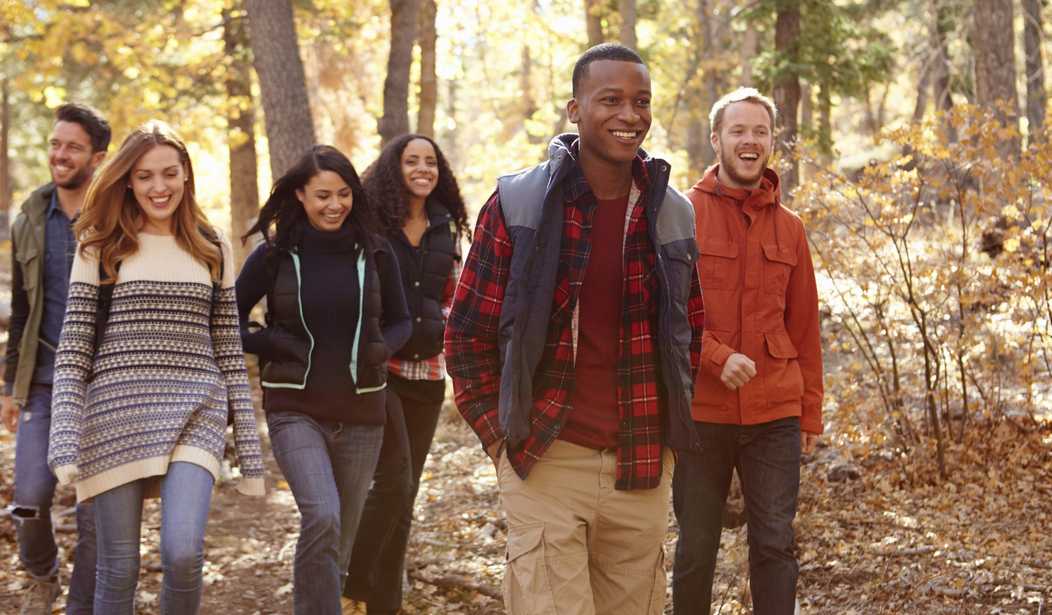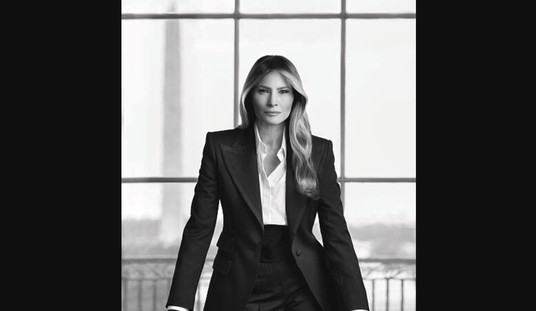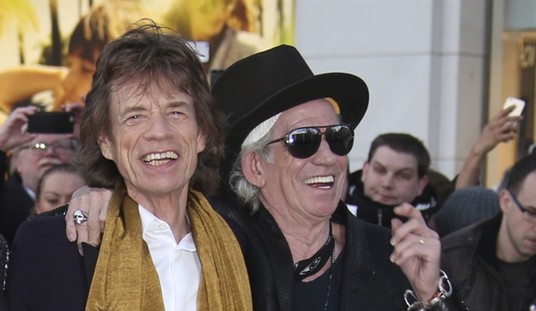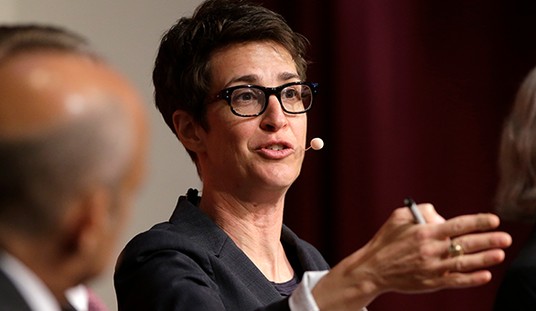Social justice warriors are fighting the alleged legacy of racism in schools, colleges, politics — and now even the outdoors. That’s right, people need a “safe space” for camping and hiking. And it gets worse: one of the “racially insensitive” things about the outdoors is the uniform for park rangers — which might upset Latinos because it looks like the uniform for immigration officers.
“How safe is that area for people of color?” asked Jenna Yokoyama, a 34-year-old Japanese-American and avid hiker in a Facebook group devoted to “Hikers of Color.” She reportedly felt threatened on the trail due to an incident of “racial taunting” in Lone Pine, California. In her interview with the Reno Gazette-Journal, however, she did not actually describe the extent of this “taunting,” which occurred several years ago. “I wanted to ask people … this specifically had to do with my safety based on my race.”
Unable to find an existing group for hiking and backpacking for minorities, she created her own closed Facebook group to ask the question. The group describes itself as “a safe space for hikers to talk about issues specific to HOCs [Hikers of Color]. This is not a group for allies, although we appreciate the support.” In other words, no white people allowed.
When she created the group, Yokoyama received both supportive and negative feedback. Commenters “accused her of everything from promoting separate trails for white people and non-white people, seeking to form exclusive cliques and even warning her to stay off the trail because she wasn’t worthy of search and rescue help should she get in trouble,” the Gazette-Journal reported.
“When I read those comments they were hurtful,” Yokoyama told the Gazette-Journal. “They were also not surprising.” She argued that white people not only dominate the hiking and camping communities, but that they are often hostile to people of other races.
“The hiking community is not just about the idealized Thoreau idea of what it is to be in the wilderness,” she argued. “The negative things of real life still happen and I think we need to acknowledge that. And the negative thing for people of color is that racism still follows them.”
The Gazette-Journal reported, as if aghast, that “although demographic data show non-white people are a growing segment of the population, particularly within the millennial generation, they’re still greatly outnumbered by white people in the outdoors community.” Sure, perhaps that’s because white people are still the demographic majority in the entire country, something the journal admitted won’t change until 2043, according to recent demographic trends.
Don’t get me wrong, anyone who says that a hiker does not deserve search and rescue merely because they prefer the company of other non-whites is definitely off his rocker. That is a clear example of cyberbullying and whoever wrote that should be ashamed of himself. But I wonder just how threatening the original “racial taunting” really was.
Next Page: The Gazette-Journal‘s one concrete example of “racism” on the trail.
The Gazette-Journal was able to provide one concrete example of this “taunting,” and it effectively consisted of a white woman making a fool of herself. Israel Borokini, a 34-year-old immigrant from Nigeria, said that many Americans in Nevada “look amazed that they see one black dude hiking.” Borokini developed his love of nature and hiking from his youth in Nigeria, and he is studying conservation biology in graduate school, so he is certainly no novice.
Nevertheless, in a group hike, one woman tried to complement him by saying his hiking showed he had “absorbed a lot of American culture.” At this, “I was just giggling, I wasn’t expecting that. It is just pat of me, I don’t see it as American culture,” the Nigerian explained.
Is this really an example of racism? We don’t have enough details to be sure. Many Nigerians have recognizable accents, and it’s entirely possible the woman realized he was foreign. Even if the woman’s comment was entirely attributable to racism, this is hardly cause to call racial minorities “targeted” on the hiking trail.
But the Gazette-Journal report is surprisingly revealing. These two “hikers of color” are actually fellow travelers in an organized movement. The paper quoted Zoe Polk, a national program director for Outdoor Afro, an organization which exists to promote black people in the outdoors.
Polk argued that outdoors culture and businesses are “very cliquish,” and demonstrate racism by using a narrow definition of outdoors activity. “If you are mountain biking on the Tahoe Rim Trail then you are an outdoorsy person, but if you are staying in a hotel and going to the beach you are not.” Polk never explains how this distinction plays into race — it seems more to do with physical exertion, and I would argue it’s a perfectly legitimate distinction.
More interestingly, Polk argued that there is racism in the outdoors industry’s promotion of white hikers and campers over HOCs. She noted that Underground Railroad conductor Harriet Tubman had to lead escaped slaves through difficult outdoors terrain, navigating by the stars and using various outdoors skills. “Black people have always been using the outdoors,” she argued. “But to call Harriet Tubman a hiker, people don’t do that.”
Perhaps that’s because people might find it insensitive to reduce Harriet Tubman’s heroic acts against slavery to the level of outdoor recreation. Imagine what the NAACP would do if someone claimed Tubman’s main contributions were in the realm of hiking and camping.
Of course, there are black explorers who might often be overlooked, such as Stephen Bishop, who explored the Mammoth caves in the 1800s, and James Beckwourth, who is credited with creating a route between Reno, Nev., and Oroville, Calif. These explorers should be remembered — for their accomplishments, not just their race.
Next Page: Outdoors businesses are so “racist,” they’re already starting to cater to non-whites.
The Gazette-Journal also cited the Outdoor Industry Association, a trade group which found that among young people, non-whites are becoming more involved in the industry. Between 2007 and 2013, black participation jumped from 8 percent to 11 percent, Hispanic participation rose from 7 percent to 10 percent, and Asian/Pacific Islander participation increased from 4 percent to 7 percent. These numbers cannot reflect the racial makeup of all hikers and campers, however, just those buying gear.
Naturally, companies like outdoors retailer REI are changing to appeal to a more racially diverse clientele. “We know that this is the most diverse generation in history,” Laura Swapp, director of public affairs and marketing at REI, said of the millennial generation. “From a business standpoint it is really seen as a sustainability issue” to include people of other races in the company’s product marketing.
This is a smart move, but hardly something to be hailed as groundbreaking. Indeed, Swapp partially explained the marketing switch in terms of becoming more social and group-focused. “There has been this legacy of the white, performative loner type,” she noted. “The outdoors industry realizes that is changing. It resonates less.”
So wait — cultural factors are already pushing businesses to cater to minorities, without an “awareness” movement? Unbelievable! Perhaps the free market naturally adjusts to include potential customers, because businesses make more money that way.
The most egregious part of the Gazette-Journal article, however, was the suggestion that uniforms worn by park rangers might be offensive to Latinos because they remind them of immigration and customs officers. Glenn Nelson, a Japanese-American who has researched and written about diversity in the park service, argued that the gray-and-green ranger uniforms are “uncomfortably similar to those worn by immigrations and customs officers.”
Oh, so now we’re encouraging illegal immigrants to get into camping, and insulting the Latino citizens and immigrants who came to this country legally by stereotyping an entire racial group as afraid of immigration officers. “The face of your park are your rangers and if they are wearing uniforms that instill fear and discomfort you are not going to get those people,” Nelson argued. Perhaps one should ask why the parks should cater to those afraid of immigration officers in the first place.
Throughout, the article mentions that non-white people feel alienated or threatened on the trail, but cannot come up with any better arguments than cyberbullying, a vague instance of “racial taunting,” a white woman making a fool out of herself, and the color of park ranger uniforms. Meanwhile, the Gazette-Journal acknowledges that the culture is already changing and the market is already adjusting to include minorities in the outdoors industry.
But by all means, let’s decry the latent racism in the outdoors. It is clearly a tremendous social problem.









Join the conversation as a VIP Member